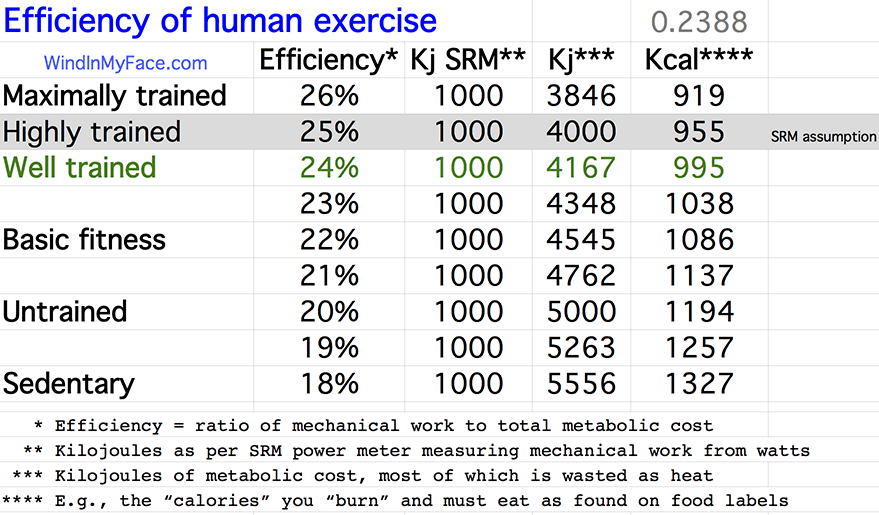
$220 SAVE $130 = 37.0% Western Digital 16.0TB Western Digital Ultrastar DC HC550 3.5-in… in Storage: Hard Drives
|

|

|

|

|
Understanding Work Efficiency, Kilojoules and Kilocalories
Muscle efficiency—the ratio of mechanical work output to the total metabolic cost, in essence, how much food one would have to eat* in order to perform the workout, e.g., to “calories” as found in nutritional info labeling.
Muscle efficiency varies from 19% (sedentary untrained) to 26% (maximally trained). It is a function of several factors:
- Training level combined with personal physiology (natural ability).
- Workload intensity. For example, long slow distance versus anaerobic intervals lead to less or more efficiency in producing energy.
- Environmental and other factors (altitude, core body temperature, etc).
Post-workout there is a metabolic cost for recovery and repair, but that is independent of and in addition to the metabolic cost while performing the workout. Young athletes that are still growing of course have additional metabolic needs.
* Setting aside digestion efficiency including thermic losses during digestion, which vary by food type; a sugary drink has far lower caloric loss than, say, meat.
SRM Kj acccuracy vs most fitness devices Kcal estimates
Many fitness device display “calories” (Kilocalories), taking nto account a muscle efficiency factor which is generally not specified. That baked-in assumption can lead to gross errors, as can be seen in the KCal variance in the table below for the same workout with different muscle efficiency figures.
The foregoing is hugely relevant for any athlete trying to balance food intake against workout levels. A sedentary untrained person will expend far more calories for the same workout than a highly trained athlete.
When the SRM power meter or software displays energy for a workout, it is Kilojoules of mechanical work. Thus the SRM approach lets the athlete figure his/her own muscle efficiency in order to calculatle Kilocalories (e.g. how much to eat).
Over time, if one carefully tracks (1) food intake and (2) weight and (3) workout Kj with the SRM, it’s possible to zero in on an accurate metabolic efficiency figure for oneself (which incorporates everything from thermic losses from digestion to muscle efficiency to recovery/repair metabolic costs).
The somewhat frustrating result of years of extended training is that higher efficiency means that losing body fat becomes more difficult, because the body becomes more efficient in every aspect of its operation! Your author figures his own efficiency as approaching 26% and knows that effect all too well.
Continues below.

Observe the huge Kilocalories variance, which depends on muscle efficiency
SRM
When the SRM power meter or software displays energy for a workout, its figure is Kilojoules (Kj) at the crank as measured by SRM crankset.
Since, the Kj figure reported by the SRM power meter is mechanical work as measured by the power meter, it does not incorporate muscle efficiency. Thus the metabolic cost is about 4X higher for a well trained athlete.
Kcal = Kj * (1 Kcal / 4.1868 Kj) * Me
Kcal = Kilocalories, e.g., “calories” as found in nutritional info labeling
Me = muscle efficiency (19% to 27% = 0.19 to 0.27)
These numbers are the product of the metabolic efficiency and the Kj to KCal ratio for figuring “calories” for tracking weight loss:
26% = 0.9186 (very highly trained)
25% = 0.9554 (highly trained, SRM power meter assumes this figure)
24% = 0.9952 (well trained)
23% = 1.0385 (trained)
20% = 1.1942 (untrained)
Most athletes can thus read of the SRM Kj number and take it as calories (close enough for most purposes given all the variables).
Seagate 22TB IronWolf Pro 7200 rpm SATA III 3.5" Internal NAS HDD (CMR)
SAVE $100



